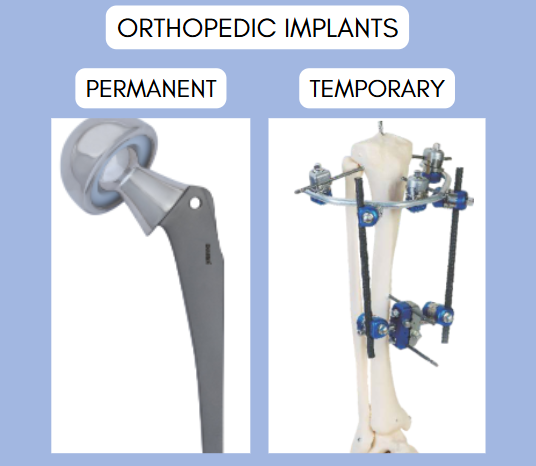
Orthopedic implants serve a vital purpose in helping patients regain movement, improve flexibility, and correct issues caused by bone deformities. In some cases, these devices are only needed for a short period, while in others, they are intended to remain in the body permanently. More often, the nature of the injury or condition and the role the implant plays in recovery determine whether used orthopedic implants used will be temporary or long-term.
The team of experts at Sharma Orthopedic specializes in crafting both temporary and permanent implants, designed to meet a wide range of clinical needs. In this blog post, we’ll take a closer look at how these two types of implants differ, where each is typically used, and the key factors surgeons consider when choosing between them.
What Are Permanent Orthopedic Implants?
The permanent orthopedic implants remain in the body for a long time. These are manufactured using the most biologically compatible and robust material, as they tend to provide long-term stability to the affected bone or joint. Permanent orthopedic implants eventually, over time, become an integral part of your body and are removed only in case of any complication. You can consider the “Intertrochanteric Antegrade Nails” as an example of permanent orthopedic implants.
Where Are Permanent Orthopedic Implants Commonly Used For?
-
Spinal fusion
-
Total joint replacement (knee and shoulder)
-
Permanent intramedullary nails
-
Certain fractures and screws which are implanted for a lifetime usage
-
Hip prostheses
Top Features of Permanent Orthopedic Implants
-
Biologically compatible and sturdy materials like cobalt-chromium, titanium, stainless steel, etc., are used to manufacture these orthopedic implants.
-
There is rarely a need to remove permanent implants unless they cause problems. These implants undergo a biological process called osseointegration, due to which these devices get fused with the affected bone to provide stability.
-
Good-quality implants can last over 20 years with proper care.
-
The longevity of an implant, however, depends on the patient’s lifestyle, physical activity, bone health, and postoperative management. Apart from this, it is also decided based on the surgeon’s practice and implant quality.
What Are Temporary Orthopedic Implants?
As the name implies, these orthopedic devices are only meant to be placed in the body surgically for a shorter time. Once their purpose is fulfilled, these are either removed or they get dissolved completely. For an example, you can consider one of the most common orthopedic implants - Headless Compression Screws” as an example of temporary orthopedic implants.
These implants provide a bone that has suffered a fracture or other severe damage with stability and support. The temporary implants are removed surgically after the bone has healed properly.
Key Applications of Temporary Orthopedic Products
Important Features of Temporary Implants
-
Constructed primarily from stainless steel or innovative biodegradable materials designed for temporary use within the body.
-
Remain implanted for variable time frames ranging from several weeks to multiple months, with duration specifically tailored to individual healing requirements.
-
These types of implants require a secondary surgical procedure for removal once healing is complete.
-
Designed with intentional simplicity compared to permanent alternatives, focusing on immediate stabilization rather than long-term integration.
-
Offer significant cost advantages over permanent implant solutions due to simplified design and materials.
-
Provide medical professionals with the flexibility to adjust during the healing process as needed.
-
These can be surgically removed once they've fulfilled their purpose of supporting tissue regeneration.
-
Particularly valuable in cases where anatomical changes are anticipated during recovery.
-
Engineered to maintain structural integrity for precisely the duration required, no longer.
-
Permit surgical revision if complications arise or healing progresses differently than expected.
-
Often feature design elements that facilitate easier removal procedures when their function is complete.
Key Differences Between Permanent and Temporary Orthopedic Implants
The most common difference between these two implants lies in their material and production design. It is a known fact that permanent implants are used in cases where the body is dependent on these medical devices for regular functioning. These are the scenarios of joint replacements or spinal reconstruction.
-
Highest durability
-
Amazing biocompatibility
-
Lower wear and tear rates
-
Long-term stability inside the body
Temporary implants, in contrast, are used during a phase of healing. Once their job is done, which is usually after the bone has healed or the structure is stable, they are no longer needed. These implants are removed or, in the case of bioabsorbable versions, naturally broken down and absorbed by the body.
Choosing the right implant is key to making it last. Surgeons consider the patient’s health, age, healing time, and treatment plan to maximize the longevity of these orthopedic implants.
Our Takeaway
We can say that both permanent and temporary orthopedic implants are equally important, given their respective functions. While the former one offers lifetime support and flexibility to move around freely, the latter promotes complete healing of fractured bone by providing it stability.
At Sharma Orthopedic, we commit to assisting the orthopedic surgeons with trustworthy and high-quality implants that are reliable for every type of procedure. Whether needed for a long-term knee joint replacement or as temporary support after a fracture, our products are designed to meet all your requirements. Our designs consistently ensure durability, patient safety, and the precision required for the longevity of an implant.